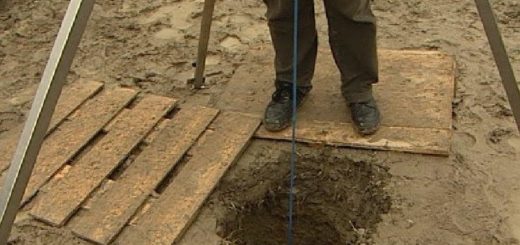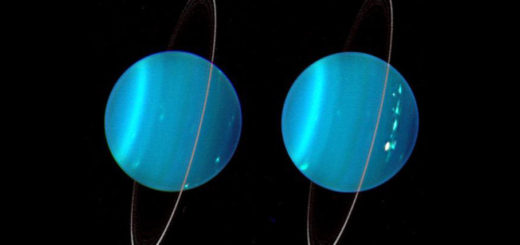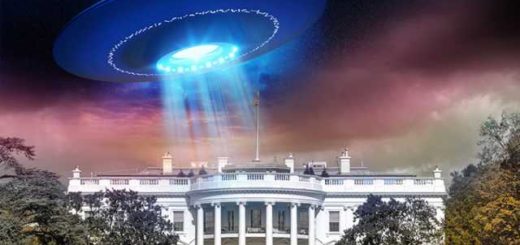Did ancient aliens and exploring Egyptians visit Australia 50,000 years ago?

Over the Australia-Day long weekend, the world was hammered with History Channel’s perspective of our Land Down Under.
One show cited Indigenous art as absolute evidence of ancient alien visitation.
Another ‘finds’ Australia’s own version of Stonehenge.
And then there’s the increasingly popular notion that this continent was explored by … ancient Egyptians.
But it takes barely more than a scratch at the surface of each of these stories for them to start unraveling. So why does a network with the grandiose name like the History Channel so consistently indulge in such flights of fancy?
“It’s really unbelievable that the History Channel chose not to speak to any archaeologists about this — all of these supposed sites of Egyptian or Phoenician settlement have been debunked over and over,” Flinders University archaeologist Dr. Alice Gorman told News Corp. “I guess they wouldn’t have had the story they wanted …”
EGYPTIAN EXPLORERS?
The Ancient Aliens promotion is credulous: “Deep in the Brisbane Water National Park is a mysterious site known as the Kariong Glyphs. The site consists of two massive eight foot (2.4m) high walls engraved with 300 ancient carvings — carvings that experts say do not resemble indigenous artwork, but Egyptian hieroglyphs.”
Trouble is, the site isn’t mysterious.
They are naturally formed rocks, not artificial walls.
The ‘ancient’ engravings are no more than 50 years old.
Yes: they do ‘resemble’ Egyptian hieroglyphs.
But they’re not authentic.
Brisbane Water National Park, Gosford, is about an hour’s drive north of Sydney.
It’s become something of an alternate history flashpoint.
Some insist the carefully collected — and bitterly contested — lines of research that form our academic understanding of the past cannot be true.
How can so many diverse cultures across the enormity of the planet so often separately discover the same solution to the same problems, they ask?
Surely there must have been an ancient source of knowledge — a ‘super race’ such as Atlantis, or prehistoric manipulations by aliens — to help these ignorant ape-descendants along their path to enlightenment?
In the case of Gosford, the only thing apparently linking it with a civilization 13,200km and 4500 years away are 250 remarkably childlike hieroglyphs gouged into a rock face.
The eroded grotto rock structure is within 100m of a road, and near an old housing subdivision. But no verifiable mention of the hieroglyphs was made before the 1970s.
This is itself odd. It’s not as though the region hadn’t been explored many times previously. And anthropologists and treasure hunters seeking Aboriginal rock art had repeatedly scoured the area since the late 1800s, and especially during the 1920s Great Depression.
Not one of them mentioned Egyptian hieroglyphs.
How did they all overlook such an easily accessible, promising rock grotto?
DREAM TIME
History Channel’s Ancient Aliens calls local historian Ray Johnson an Egyptologist. He wasn’t. He was a self-professed amateur enthusiast who died in 2004. He was so excited by the appearance of the hieroglyphs he translated them himself. He insisted the pictograms proclaimed the site to be the burial place of Lord Nefer-ti-ru.
We know he sent letters seeking verification of his find to experts in both Egypt and Australia. We don’t know if anyone replied.
“There is also an eminent Egyptologist called W Raymond Johnston from the University of Chicago. Confusion about him and the amateur from Australia has been used to fuel uncertainty about the legitimacy of the claimed reading of the inscription,” says NSW senior heritage specialist and archaeology doctorate student Mr. Denis Gojak.
Gosford’s Mr. Johnson said the glyphs told the tale of the intrepid member of the Egyptian royal family who died in the area while leading an expedition with his brother, Nefer-Djeseb.
The story flared again in 2012.
Dr. Hans-Dieter von Senff (a Doctor of Philosophy) declared he had found a new chamber above the Kariong Glyphs, suggesting the NSW site of Woy Woy had been an Egyptian settlement some 5000 years ago.
‘‘Australia was discovered in the Third Dynasty (Egypt’s Old Kingdom). The Egyptians landed at Cape York Peninsula and moved south,’’ Dr von Senff said in a press release at the time.
To support this claim, History Channel interviews ‘local ancient astronaut theorist’ Evan Strong while visiting the site.
“Wow … That’s incredible …”
Then the supposed tale the stones record is recited:
“At least one panel talks about two brothers, two princes, coming here from Egypt. They were shipwrecked. One of them ended up getting bitten by a snake. He then died. The theory is then he was interred here and that’s why you’ve got hieroglyphs here,” Mr. Strong says.
“But, there’s these other walls with a mixture of symbols. This one over here is more of a philosophical, astrophysics style thing with symbols meaning all sorts of esoteric stuff …”
But, aliens?
“So this one here we call the UFO glyph, and people have called it that since they’ve been coming here because it kind of looks like a UFO …”
“It definitely has the classic UFO shape…,” the commentator observes.
“I think someone suggested jewelry, but it’s a completely different symbol that’s upside down and it really doesn’t quite fit in. It’s one of those symbols here that doesn’t fit into the canon.”
UNDER THE MICROSCOPE
There’s a reason so many of the symbols don’t fit the ‘canon’ of any Egyptian-era text.
They’re not.
The Gosford History Group has repeatedly told different researchers over the years that the engravings were made by schoolchildren in the 1960s.
And the council worker who first reported them, Alan Dash, has described how he noticed large glyphs had been added between his visits in the early 1970s.
Blogger Steve Spillard has undertaken a deep-dive into the history and mythology of the Gosford ‘glyphs. His work can be found here.
A quick look at the hieroglyphs show them to be remarkably clean, sharp-edged and unweathered for their alleged 4500-years of age.
It’s doubly unusual given the comparatively high rate of erosion for local sandstone.
This was something highlighted by a late 1970s survey by the National Parks and Wildlife service. It found the engravings were so fresh the exposed rock was bright and white, even where the hieroglyphs had been cut through lichen growths.
Once qualified Egyptologists looked at them, they found the form of the engravings to be … amateurish. The simplistic symbols were randomly arranged — not in the neat structured rows found in actual Egyptian engravings. That, and the fact different forms on the rock face were used in a variety of eras thousands of years apart.
It was, they said, as though someone had been looking at Egyptology books, picking and choosing the characters that inspired them most.
Professor Boyo Ockinga from Macquarie University’s Ancient History Department in Sydney, told the ABC in 2017: “I’d be the first person who’d welcome some sort of link that because it would make my subject relevant to Australian history. It’d be wonderful … but I’m afraid it’s just not possible.
‘‘People just don’t want to believe they are fake; they want this connection with ancient Egypt to be true, but unfortunately, it’s not.’’
Dr. Gorman is less diplomatic: “This obsession with finding evidence of ‘classical’ civilizations is really just about legitimatizing the theft of Aboriginal land, like altering a will to steal someone else’s inheritance. It’s a pretty tired cliche by now.”
EXPLODING MYTHS
Tales of Ancient Egyptians visiting Australia are nothing new.
In 1875 Chevert expedition traveled up the Queensland coast to Papua New Guinea ‘for the promotion of science’. It was a well-documented mission, as the University of Sydney highlights.
Torres Strait traditions included preserving some bodies, but it was not mummification in the Egyptian sense.
“ The claimed parallels were exploited by Australian anatomist and physical anthropologist Grafton Elliott-Smith, whose idea was that most critical cultural innovations associated with civilization originated in Egypt and spread outwards from there,” says Mr. Gojak. “His ideas became known as the Hyper-diffusionist school of thought. It was heavily debunked at the time [early 20th century] and has no credibility with archaeologists now because it is completely contrary to the evidence.”
Then there’s Walsh’s Pyramid. It’s a 922-meter tall sandstone peak with a roughly pyramidal appearance about 20km south of Cairns in Queensland. It isn’t all that odd. A pyramid is a naturally stable shape, which is why most mountains roughly look that way. It’s also why the Egyptians built pyramids in the first place.
This particular mass fully conforms with the geology of the landscape. And there are no signs of ancient artificial assembly or earthmoving.
But that doesn’t stop it being cited as further evidence of Egyptian visitation.
As is the case of a bronze coin minted in the era of Ptolemy IV (221 and 204BC).
It was reportedly found by a farmer digging a post hole in a far north Queensland rainforest.
Whatever the case, the finder — Andrew Henderson — said he had shoved it in a draw and forgotten about it for some 40 years. That’s when he handed it over to the neighbor’s son.
Later, Hank Gilmore handed the coin and its tale over to the Cairns Museum.
How did it get there? A careless Egyptian explorer? Indigenous traders? Or an unlucky gold prospector?
It comes down to context.
Indigenous traders and thousands of hopeful gold prospectors were known to have used a trail that passed through Henderson’s land. And the region has a total lack of any other link to Ancient Egypt.
Dr. Andrew Connor, a lecturer in ancient history from Monash University, told the ABC last year that the coin was most likely dropped by a miner. “We know conclusively that this is the sort of thing that people would bring with them when they emigrated to Australia in the 19th Century,” Dr. Connor said.
Dr. Gorman says she is dismayed at how so much airtime is given to such Euro-centric flights of fancy.
“Wouldn’t it have been nice to focus instead on real achievements of Aboriginal culture and science — the tidal fishtraps made of extensive stonework, the mining and geology of stone tool industries, and the monumental works of art, such as you see on the Burrup Peninsula?” she asks.
Mr. Gojak says some of the responsibility must also be borne by Australian archaeologists and historians: “‘Ultimately much of the idle speculation about other civilizations comes from a perception that Australia’s actual human history is dull and unexciting. It should be a challenge to educators and professionals in history and archaeology to fairly represent the amazing complexity and texture of our history. That is our best defense against cranks and pseudoarchaeology.”



 Creators of mankind
Creators of mankind Description of “Tall white aliens”
Description of “Tall white aliens” Where they came from?
Where they came from? About hostile civilizations
About hostile civilizations The war for the Earth
The war for the Earth “Tall white aliens” about eternal life
“Tall white aliens” about eternal life Video: “Nordic aliens”
Video: “Nordic aliens” Aliens
Aliens Alien encounters
Alien encounters The aliens base
The aliens base UFO
UFO Technology UFO
Technology UFO Underground civilization
Underground civilization Ancient alien artifacts
Ancient alien artifacts Military and UFO
Military and UFO Mysteries and hypotheses
Mysteries and hypotheses Scientific facts
Scientific facts


















